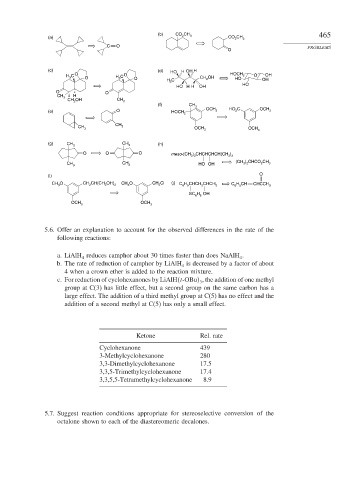Page 492 - Advanced Organic Chemistry Part B - Reactions & Synthesis
P. 492
(b) CO CH 465
(a) 2 3 CO CH 3
2
C O PROBLEMS
O
(c) (d) HO H OH H
H C O C O OH HOCH 2 O OH
3 O H 3 O H C CH 2 HO OH
3 HO
HO H H OH
O O
H
CH 3
CH OH CH 3
2
(f) CH
3
(e) O HOCH OCH 3 HO C OCH 3
2
2
CH
CH 3 OCH
3 OCH
3 3
(g) CH 3 CH 3 (h)
O O O meso-(CH ) CHCHCHCH(CH )
3 2 3 2
CH CH HO OH (CH ) CHCO CH 3
2
3 2
3 3
O
(i)
CH 3 O CH CH(CH OH) CH O CH Cl (j) H CHCH CHCH C H CH CHCCH
2 2 2 3 2 C 6 5 2 3 6 5 3
SC H OH
5
6
OCH OCH
3 3
5.6. Offer an explanation to account for the observed differences in the rate of the
following reactions:
a. LiAlH reduces camphor about 30 times faster than does NaAlH .
4
4
b. The rate of reduction of camphor by LiAlH is decreased by a factor of about
4
4 when a crown ether is added to the reaction mixture.
c. For reduction of cyclohexanones by LiAlH t-OBu , the addition of one methyl
3
group at C(3) has little effect, but a second group on the same carbon has a
large effect. The addition of a third methyl group at C(5) has no effect and the
addition of a second methyl at C(5) has only a small effect.
Ketone Rel. rate
Cyclohexanone 439
3-Methylcyclohexanone 280
3,3-Dimethylcyclohexanone 17.5
3,3,5-Trimethylcyclohexanone 17.4
3,3,5,5-Tetramethylcyclohexanone 8.9
5.7. Suggest reaction conditions appropriate for stereoselective conversion of the
octalone shown to each of the diastereomeric decalones.

